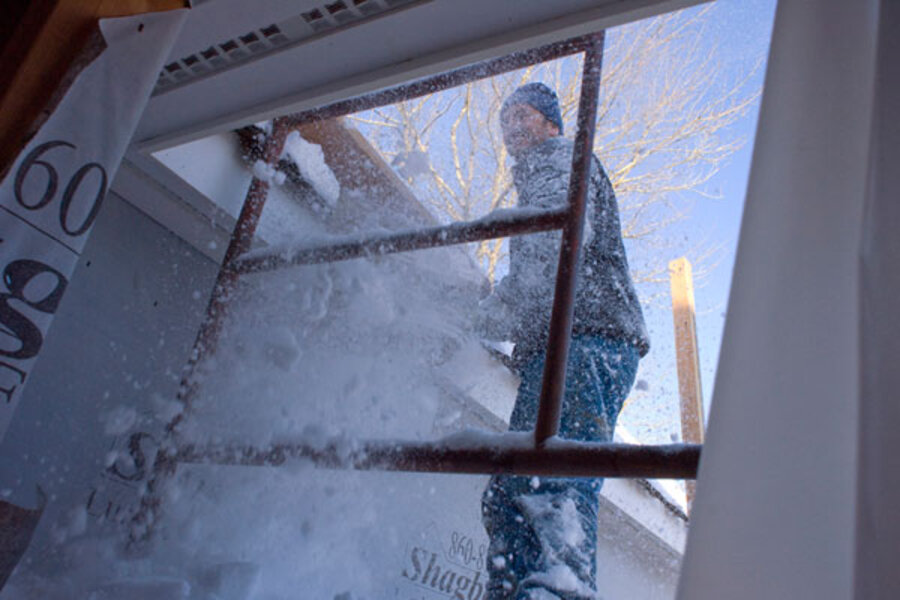The unexpected joys (and expenses) of renovating an old house
Loading...
When we began the renovation of Sheep Dog Hollow last August, one of our goals – besides doing it in a green and economical manner – was to have it “buttoned up” by the time the first snow flew. That meant that the old granite foundation had to be reinforced, a new roof put on, and energy-efficient windows all installed.
Our carpenters assured us it could be done by Christmas, at the latest.
Well, here’s to the best intentions. It’s currently the week between Christmas and New Year’s, and we’re not even close. The final concrete slab in the basement (the floor had been dirt) was finally poured last Wednesday. But the windows are just framed shells covered with plastic, and the old patched asphalt roof still sits atop the house.
That said, the old home does appear to be standing a bit taller in its bucolic setting. That’s because of all of the unexpected work that was uncovered as we began demolition of the old plaster walls.
Yes, the cedar clapboard we thought could be saved had to be torn off because the shingles were brittle and cracking, impossible to reuse. The soffits and fascia at the edge of the roof all had to be replaced because they had too many rotted spots to patch efficiently. And all of the lovely crown molding that graced Sheep Dog’s eves also had to be replaced for the same reason. Age can be a terrible thing when something is not lovingly cared for.
And that wasn’t the half of it.
We ended up reframing all 45 window openings and putting new structural beams throughout the house to allow for the open floor plan Martin insisted on in the living room. Oh, yes, we also had to tear down one of the old chimneys we thought we could saved for a fireplace in the kitchen. It turns out it had originally been used for a wood-burning stove and was too narrow to meet current building and fire-code regulations (even for a contemporary wood stove.)
Mind you, I’m not complaining. By God’s grace, this renovation has gone smashingly well compared with other stories I’ve heard. Check out OldHouses.com for some genuinely hair-raising tales of renovation woes – from dealing with inept and corrupt contractors to spending years living in a construction site.
My favorite tale, though, was dubbed the Devil Queen by its owner: How my wife and I sold our souls to the Queen Anne Victorian we tried to save:
This is a cautionary tale. A seriously disturbed couple find the charming, old ruin of a Queen Anne Victorian in Russellville, Ark., and buy it for $1.00. They tore the roof off, cut it in half, and had it moved to some land they owned 16 miles away because they didn't know any better. Since then, they have hired and fired contractors, had all of their tools stolen, rewired, replumbed, insulated, and essentially rebuilt the entire house. Their only problem is that after four years, it still isn't finished. Now they are tired, broke, and wonder what ... they've done to themselves.
I’m waiting for the major motion picture.
No, if we’ve had some unexpected work crop up, it will only make the house sturdier and more durable for the many generations to come that we hope will enjoy it.
Yes, every time the phone rings (as it just did) with one of our carpenters on the line explaining that a wall would be better moved eight inches toward the center of the house (as he just did in the second floor guest bedroom to make it a more manageable size and the better to install one of the new support beams), Martin and I examine the pros and cons, the extra costs, and the long-term impact of the unexpected change and usually agree with its necessity.
And so, time passes, the first snowflakes have flown – in fact, we’ve already had a blizzard – and the house isn’t buttoned up yet.
Next: Sheep Dog Hollow as winter wonderland, or How to hammer in 20-degree temperatures.
Editor’s note: Alexandra Marks blogs on Tuesdays and Thursdays about her green and budget-friendly restoration of a 1902 farmhouse in Connecticut.
The Monitor's Environment section has a new URL. And there's a new URL for its Bright Green blog. We hope you'll bookmark these and visit often.





